Tips and Tricks
Home Barista: How to Build a Coffee Bar at Home!
Hone your barista skills at home with these expert tips for creating the ultimate coffee bar – perfect for coffee enthusiasts and DIY aficionados alike!
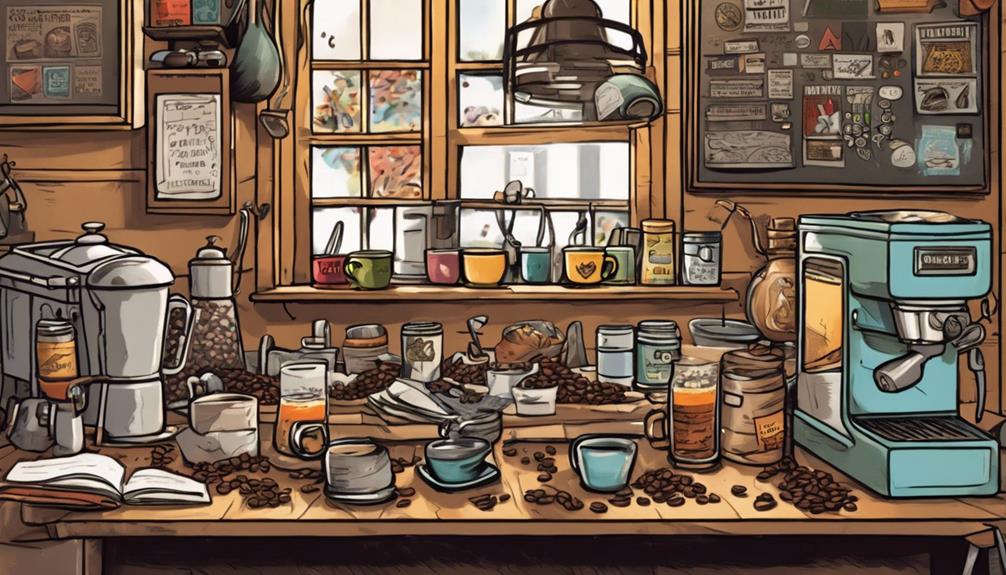
Create your own coffee haven at home by setting up the perfect coffee bar with these steps: Pick a spot with water and electricity, use vertical storage, and organize all essential tools. Equip yourself with a coffee maker, burr grinder, scale, and gooseneck kettle. Choose a cozy space, set up your station, and add personal touches. Opt for sleek white cabinets or warm wood shelving for a stylish design. Keep organized with shelving, hooks, and smart storage solutions. Enjoy the process of creating your coffee haven!
Key Takeaways
- Choose a spot near water and power sources.
- Utilize vertical storage with shelving and hooks.
- Ensure clearance for appliances in functional setup.
- Personalize with stylish design ideas like white cabinetry.
- Organize efficiently with smart storage solutions.
Location Selection
When setting up your home coffee bar, the first step is selecting the ideal location for convenience and functionality. Consider placing your DIY coffee bar near a water source and electrical outlet to make brewing your morning espresso a breeze.
Maximize your space by utilizing vertical storage options like shelving and hooks for cups, mugs, and coffee accessories. Confirm there's enough clearance for your coffee maker or espresso machine, grinder, and any other appliances you plan to include in your functional coffee station.
Think about the flow of your home and place your coffee bar in a room where it's easily accessible, such as the kitchen, dining room, or a common area. Proximity to high-traffic areas is beneficial, especially if you enjoy hosting guests and want to offer them a freshly brewed cup of coffee.
Get creative with placement options like a dedicated coffee cart or a stylish bar setup to make your coffee bar a focal point in your home.
Equipment Essentials

Consider the necessary equipment required for a functional home coffee bar, ensuring you have the tools necessary to brew your favorite coffee beverages with precision and consistency.
Here are four must-have items for your coffee bar at home:
- Coffee Maker: A reliable coffee maker is the cornerstone of your setup, whether you prefer a classic drip brewer or a sleek espresso machine.
- Grinder: Invest in a burr grinder to achieve a consistent grind size, essential for best extraction and flavor in your coffee.
- Scale: A precision scale is vital for accurately measuring your coffee grounds and water, ensuring a perfect brew every time.
- Kettle: Opt for a gooseneck kettle to have precise control over water flow, ideal for pour-over brewing methods that require a steady hand.
Setup Process Overview
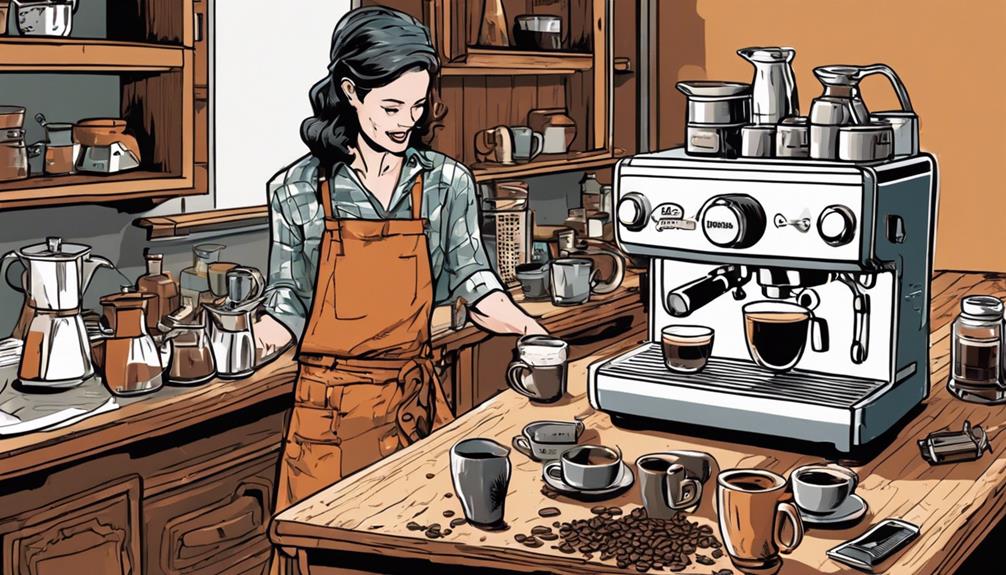
Start by outlining the step-by-step process for setting up your home coffee bar efficiently and effectively. Setting up a home coffee bar efficiently and effectively begins with gathering all the necessary equipment, such as a grinder, coffee beans, filters, and mugs. Next, designate a specific area in your kitchen for your coffee bar and organize all of your supplies in an easily accessible manner. Once everything is in place, it’s time to start assembling your Breville coffee machine.
Assembling your Breville coffee machine involves following the manufacturer’s instructions carefully and ensuring that all the components are properly connected and in working order. This step is crucial for the functionality and performance of your machine, so take your time and double-check everything before moving on to the next step.
Begin by choosing the perfect spot in your home, whether it's a corner of your kitchen, a section in your home office, or a cozy nook in your dining room. Consider creating a hidden coffee haven or a prominent coffee corner depending on your preference.
Next, set up a coffee station with all the essentials like your favorite coffee maker, grinder, kettle, and mugs. Arrange these items in a way that makes it convenient for you to use as a coffee lover. Test the layout to ensure a smooth workflow when you make yourself a cup of your best coffee.
Personalize your space with unique coffee bar ideas that reflect your style and taste. Embrace the ritual of pour-over coffee or any brewing method you prefer to enhance your at-home coffee experience.
Enjoy the process of setting up your personalized coffee bar and savor every cup you create.
Stylish Design Ideas

For a chic and functional coffee bar setup, infuse your space with sleek white cabinetry and subway tile to achieve a modern design.
To make your coffee bar area stylish and efficient, consider the following design ideas:
- Bright Colors and Glossy Finishes: Opt for bright colors and glossy finishes to create a spacious feel in your coffee station.
- Smart Storage Solutions: Maximize space with smart storage solutions that help keep your coffee bar area organized and clutter-free.
- Cozy Nook with Natural Wood Shelves: Create a cozy coffee nook in a small space by incorporating natural wood shelves for a warm and inviting touch.
- Vertical Storage with Stylish Rail System: Add vertical storage options like a stylish rail system to facilitate efficient organization of your coffee accessories while freeing up counter space.
Organizational Tips
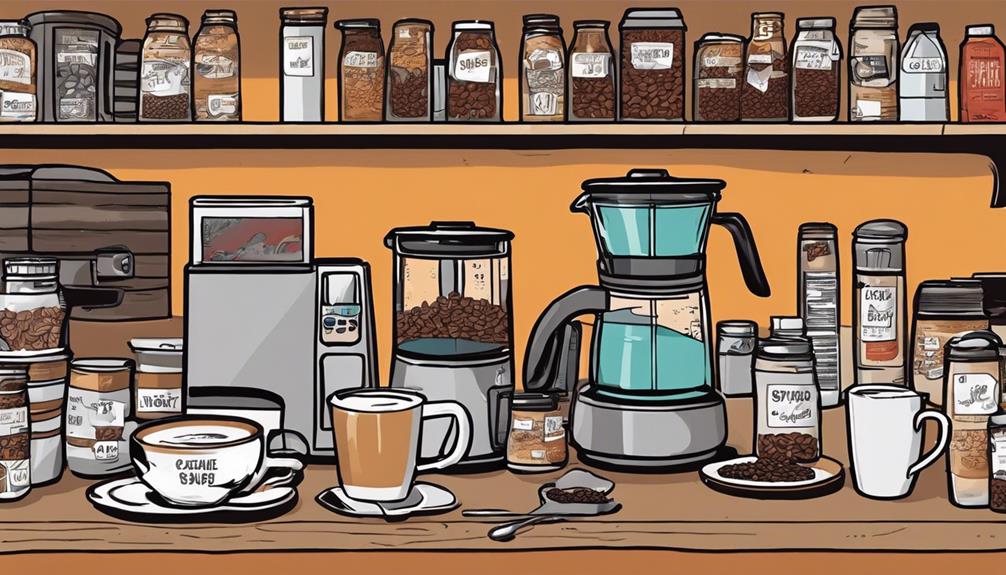
Efficiently utilize vertical space in your coffee bar by incorporating shelving and hooks for organizing your coffee accessories.
Opt for a walnut wood cabinet to create smart storage solutions, holding dishware and coffee essentials in a stylish manner.
Consider adding a rail system to your coffee bar setup; this won't only enhance the overall look but also offer a functional way to store your coffee and tea accessories.
Remember, organization is key to a well-rounded coffee bar. Accessorize thoughtfully, blending functional elements with aesthetic touches to personalize your space.
Maximize every inch by using smart storage solutions like overhead shelving and stands, ensuring a tidy and organized coffee bar where everything has its place.
Frequently Asked Questions
How to Make Your Own Coffee Bar at Home?
To make your own coffee bar at home, designate a convenient space, organize tools like a grinder and frother, set up a streamlined assembly line, and add personal touches for a cozy vibe. Enjoy your DIY coffee haven! If you find a true passion for creating your own coffee bar at home, you may even consider starting a coffee business. With your skills and knowledge of coffee preparation, you can bring your love of coffee to others by opening a small cafe or offering your personalized coffee blends for sale. The possibilities are endless once you have mastered the art of home coffee brewing.
How Tall Should a Home Coffee Bar Be?
Feeling lost about the ideal height for your home coffee bar? Aim for around 36 inches, standard countertop height. Consider comfort and accessibility for a setup that suits your needs. Customize for a perfect coffee haven!
What Should a Coffee Bar Include?
A coffee bar at home should include a coffee maker, grinder, frother, and storage solutions. Make sure to have a designated space for brewing with easy access to supplies. Enhance the aesthetics with mugs, artwork, and shelving.
How to Set up a Coffee Bar for Guests?
To set up a coffee bar for guests, designate a specific area with counter space and storage. Stock up on various coffee beans, syrups, and toppings. Provide easy access to equipment and create a visually appealing setup.
Conclusion
Now that you've got your home coffee bar set up, you're ready to brew up some delicious drinks and impress your guests.
Remember, Rome wasn't built in a day, so take your time perfecting your barista skills and enjoy the process.
Just like a fine cup of coffee, creating your coffee bar is a labor of love that will bring joy and satisfaction every time you use it.
So go ahead, sip, savor, and enjoy your new coffee oasis!
Tips and Tricks
Coffee Connoisseur: How to Age Coffee Like a Pro!
Yearn to elevate your coffee experience? Discover the art of aging coffee like a pro and unlock a world of flavor evolution!

To become an expert in aging coffee, first focus on perfecting the storage conditions: airtight, cool, and dark. Develop patience as time enriches the flavors. Keep a close eye on progress. Experiment with aging methods to perfect your technique. Try out aged coffee varieties like Monsooned Malabar for unique taste profiles. Learn about accentuated flavors and flavor evolution while tasting aged coffee. Understand the history and brands dedicated to aging to fully embrace the culture. If you are looking to elevate your coffee experience, there is a world of flavor evolution waiting for you.
Key Takeaways
- Properly store coffee in airtight containers.
- Monitor aging progress regularly.
- Experiment with different aging methods.
- Understand the impact of temperature and humidity.
- Taste and appreciate the evolving flavor profile.
The Art of Aging Coffee
Master the art of aging coffee with patience and precision to reveal its hidden flavors and aromas. Embrace the specialty coffee experience by delving into the intricate aging process that transforms a simple bean into a gourmet delight. As coffee ages, its acidity diminishes, allowing its body to shine through, resulting in a smoother and more balanced taste profile. This process reveals a myriad of nuanced flavors, creating a unique sensory journey for coffee lovers.
The European aristocracy inadvertently stumbled upon the magic of aging coffee during their sea voyages, where the beans were exposed to the elements, enhancing their quality. One exceptional example is the Monsooned Malabar coffee from India's Malabar Coast, renowned for its exquisite smoothness achieved through monsoon exposure.
Tchibo, a brand dedicated to excellence, focuses on honing the aging process by carefully selecting beans with low acidity and rich body. By mastering the art of aging coffee, you can savor the unparalleled depth and complexity that only a well-aged cup of coffee can offer.
Understanding the Aging Process
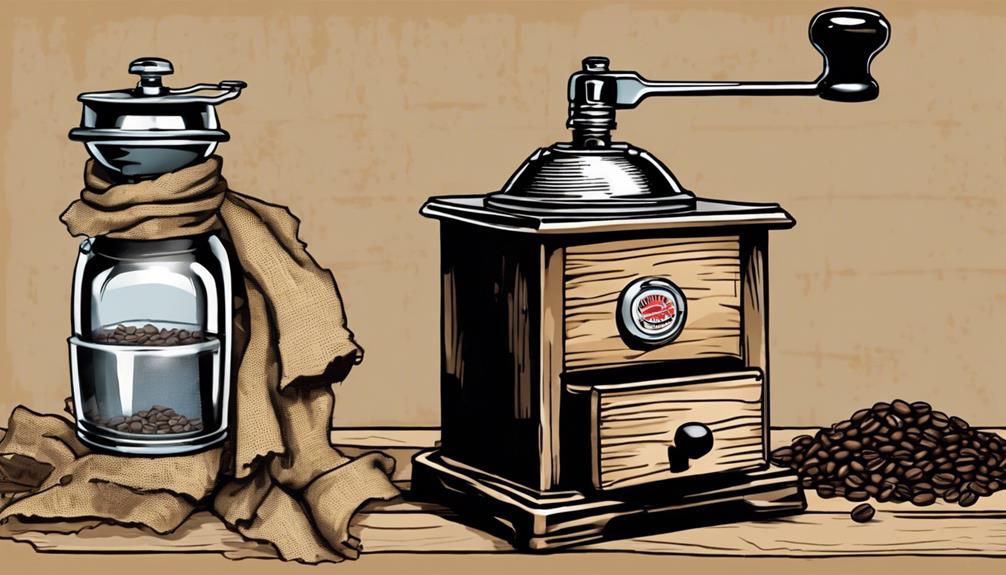
Enhancing flavor profiles and transforming coffee beans, aging is a nuanced process that alters the taste and body of the brew. Through coffee aging, the flavor profile undergoes a remarkable shift, with reduced acidity and heightened body, resulting in a smoother and more rounded taste. This process accentuates the existing flavors within the beans, providing a unique and dynamic flavor palette that distinguishes aged coffee from its freshly roasted counterpart.
Interestingly, aged coffee wasn't a deliberate practice initially. Dating back to the 1500s, during sea travel to Europe, coffee beans aged subtly due to exposure to salty sea air. This unintentional aging process led to the discovery of the flavorful nuances that aged coffee could offer.
Notably, aged coffee varieties like the Monsooned Malabar from India's Malabar Coast showcase exceptionally smooth tastes, attributed to their unique aging and production methods. Understanding the intricacies of coffee aging can profoundly impact your brewing experience and appreciation for the diverse flavors that aged coffee brings to the table.
Mastering Storage Conditions

You need to store your aged coffee in airtight containers to prevent flavor loss and oxidation. Remember that maintaining a cool, dark environment is key to preserving the freshness of your aged coffee.
Make sure to keep your coffee away from direct sunlight to safeguard its flavors and aromas.
Optimal Storage Temperature
Maintaining a consistent temperature between 60-70°F is important for the best aging of coffee and preserving its flavor integrity. Fluctuations in temperature can greatly impact the aging process, potentially leading to the degradation of the coffee's taste. Exposure to high temperatures can accelerate the aging process, causing premature flavor changes and affecting the delicate balance of coffee oils within the beans. To ensure the best aging conditions for your coffee, it is essential to control the storage environment carefully.
| Temperature Range (°F) | Impact on Aging Process |
|---|---|
| Below 60 | Slows down aging, may affect flavor |
| 60-70 | Ideal range for top-notch aging |
| Above 70 | Accelerates aging, can alter flavors |
Consistent temperature control within the recommended range is vital for preserving the nuances of aged coffee. By maintaining a stable environment, you can enhance the aging process and enjoy a more refined and flavorful cup of coffee.
Importance of Airtight Containers
How can sealed containers enhance your coffee storage game and preserve its rich flavors?
Sealed containers play a vital role in maintaining coffee freshness by shielding your precious beans from oxygen, light, and moisture. These elements are well-known for accelerating the deterioration of coffee quality. By investing in quality sealed containers, you create a protective barrier that helps retain the flavor and aroma of your coffee for a longer period.
Oxygen, in particular, is the primary culprit behind the loss of coffee freshness, making sealed containers essential for preserving your beans' quality. The reduction of oxidation and flavor loss that sealed containers provide can notably extend the shelf life of your coffee beans.
As a result, if you aim to savor the full potential of your coffee beans and enjoy a delicious cup every time, storing them in sealed containers is a simple yet essential step to master your coffee storage conditions.
Avoiding Direct Sunlight
To maintain the best flavor profile of aged coffee, ensuring it's shielded from direct sunlight is a key step in mastering storage conditions. When it comes to aging your coffee grounds like a pro, here are some vital tips to keep in mind:
- Avoid direct sunlight: Direct sunlight exposure can expedite flavor deterioration in aged coffee by subjecting it to heat and harmful UV rays.
- Choose a cool, dark storage spot: Storing your aged coffee in a cool and dark place helps to preserve its intricate flavors and delightful aromas.
- Protect from UV light: UV rays have the potential to accelerate the breakdown of coffee compounds, impacting the overall taste and quality of your aged coffee.
- Ensure proper storage conditions: Maintaining the right storage conditions, such as shielding your aged coffee from direct sunlight, is essential for upholding its best flavor profile and extending its shelf life.
Harnessing Time for Flavor Development
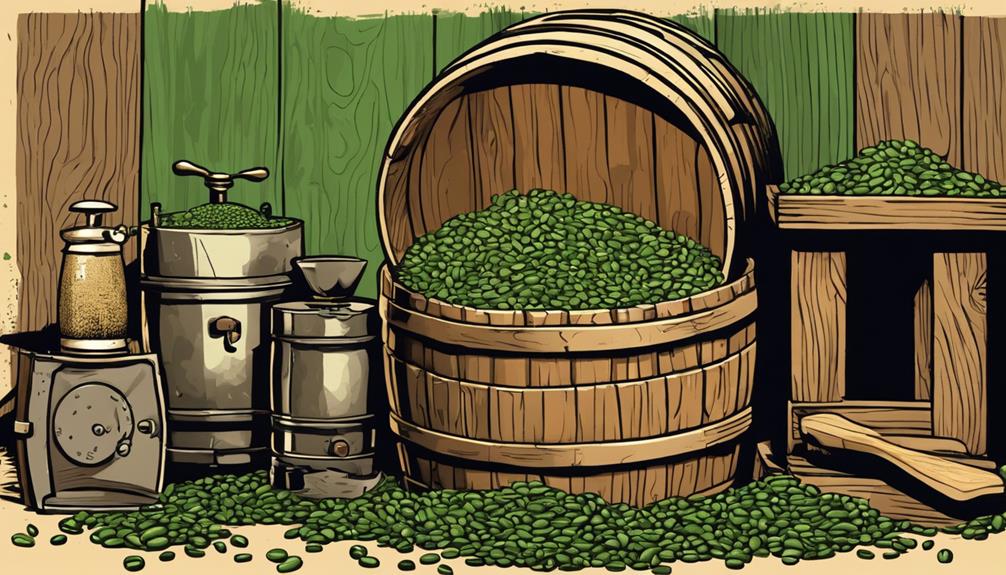
Experience the magic of flavor evolution by allowing time to work its wonders on aging coffee beans. The aging process plays a pivotal role in flavor development, transforming the beans by reducing acidity and enhancing body.
As coffee beans mature, existing flavors are accentuated, resulting in a unique taste profile that sets aged coffee apart. When aged properly, coffee offers a gourmet experience with a dynamic flavor palette that showcases the impact of time.
Each cup of aged coffee presents a journey through taste, reflecting the essence of the beans shaped by the aging process. Understanding how time influences the flavor of coffee is essential in mastering the art of aging coffee like a pro.
Monitoring Aged Coffee Progress
Begin by tracking flavor changes in your aged coffee to effectively monitor its progress over time. Conducting regular tastings is essential to assess how your coffee is developing as it ages.
By documenting aroma, taste, and body changes during these tastings, you can gain valuable insights into the aging process. Observing any color shifts in the aged coffee beans can also give you clues about the progression of flavors and aromas.
Remember to keep detailed notes on the storage conditions of your aged coffee, as this information can help you understand how different variables impact the aging effects.
Achieving Desired Flavor Profiles
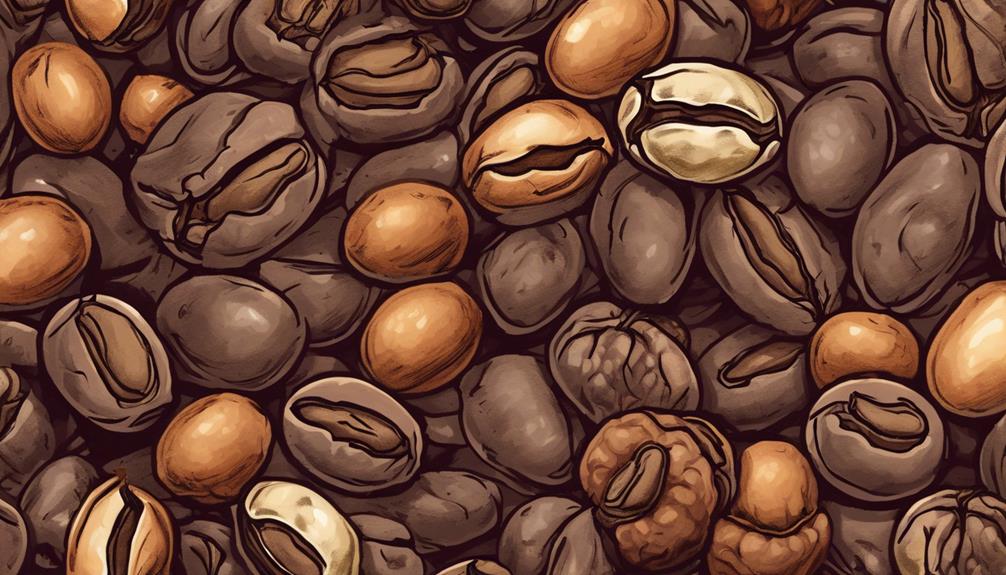
Enhance your coffee aging process by understanding how to achieve your desired flavor profiles through strategic techniques and careful monitoring. Aging coffee beans can transform their flavor profiles, reducing acidity and enhancing body to create a smoother, more complex taste.
As coffee beans mature during the aging process, their existing flavors develop and intensify, resulting in a dynamic and gourmet experience for enthusiasts. By implementing proper aging techniques, you can curate a rich flavor palette that offers a unique tasting journey.
It's important to note that aged coffee can maintain its enhanced flavor for up to 6 months, with noticeable changes occurring as it continues to age. Understanding the impact of aging on coffee flavor is vital for achieving your desired taste profiles.
Tasting Aged Coffee Varieties
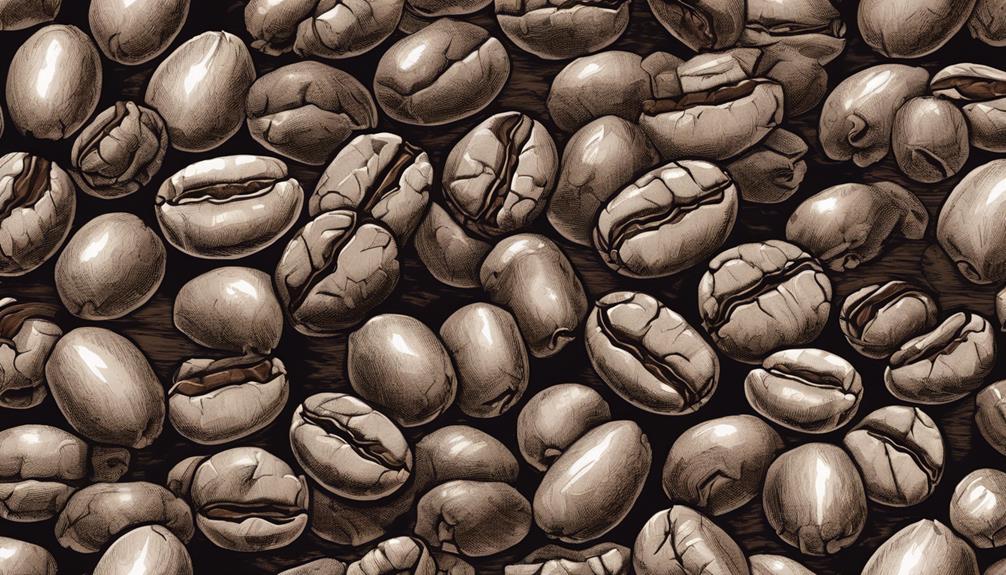
Explore the diverse world of aged coffee varieties to investigate a spectrum of flavors brought out by the aging process. Aged coffee, cherished by coffee connoisseurs, offers a unique tasting experience that showcases the intricate results of beans maturing over time.
When tasting aged coffee varieties, consider the following:
- Monsooned Malabar: Originating from India's Malabar Coast, these beans undergo a special aging process exposed to monsoon rains and winds, resulting in a smooth taste profile with decreased acidity.
- Range of Palates: Aged coffee variants present an impressive array of flavors, highlighting the diverse tastes that aging can reveal in the beans.
- Impact of Aging: Venturing into the world of aged coffee reveals a spectrum of flavors, each demonstrating the influence of aging on taste and aroma.
- Tchibo's Commitment: Brands like Tchibo actively engage in providing coffee enthusiasts with unique and diverse aged coffee experiences, emphasizing quality and innovation in aging techniques.
Perfecting the Aging Technique

To refine the aging technique, you must consider various factors that impact the flavor evolution of coffee over time. Storing your coffee in ideal conditions, monitoring humidity levels, and understanding the best aging period for different varieties are key to achieving a well-developed taste profile.
Aging Factors Impact
Understanding how different factors such as temperature, humidity, and air exposure influence the aging process is crucial for perfecting the technique of aging coffee.
To optimize aging conditions, consider the following:
- Proper Storage: Store coffee beans in a cool, dark place with limited oxygen exposure to maintain freshness.
- Time: Flavor development in the aging process occurs gradually over weeks to months, enhancing the coffee's taste profile.
- Monitoring: Regularly check on the aging process to facilitate flavor maturation while preventing any deterioration.
- Experimentation: Developing a discerning palate and trying out various aging methods can help refine the art of aging coffee.
Flavor Evolution Over Time
Witness how the flavor of aged coffee transforms over time, evolving into a rich and complex profile that enhances your coffee experience.
As coffee beans age, the flavor evolution is remarkable. The aging process leads to a reduction in acidity, while simultaneously boosting the body and complexity of the coffee roast. This transformation isn't just a simple change; it's a delicate dance of flavors that takes place within the beans.
Through proper aging techniques, the existing flavors in the coffee beans develop, creating a unique taste profile that's unlike any other. The richness and depth of flavors that emerge through aging offer a gourmet experience for those who appreciate the finer nuances of coffee.
With time, aged coffee undergoes a symphony of taste changes, shaping the essence of the beans and providing a dynamic flavor palette for connoisseurs to savor. Understanding the intricacies of flavor evolution in aged coffee allows you to perfect the aging technique and reveal a world of exquisite coffee experiences.
Aged Coffee Tasting Tips

Enhance your aged coffee tasting experience by focusing on the subtle interplay of reduced acidity and intensified body in each cup. When diving into the world of aged coffee, remember these tasting tips to elevate your coffee snob status:
- Savor the Smoothness: Distinctive varieties like Monsooned Malabar offer exceptionally smooth flavors that are a delight for your taste buds.
- Accentuate Existing Flavors: Proper aging accentuates the current flavors in coffee beans, bringing out hidden nuances and complexities.
- Dynamic Flavor Palette: Aged coffee tasting reveals a diverse flavor palette, providing a gourmet experience with each sip.
- Unique Flavor Profiles: Prolonged aging shapes the essence of the coffee bean, creating distinct flavor profiles that set aged coffee apart from the rest.
Embracing Aged Coffee Culture
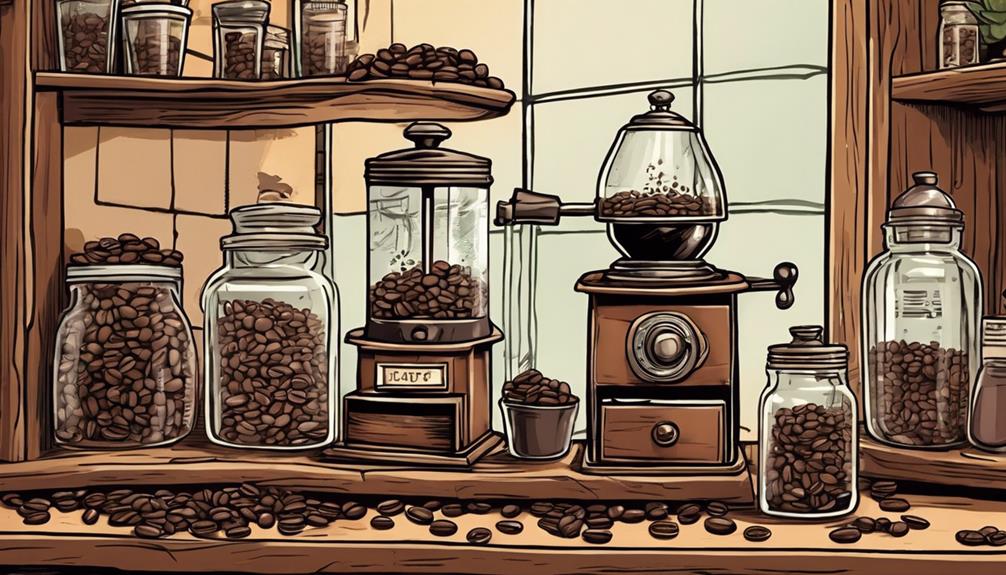
Explore the rich history and flavorful traditions of aged coffee culture to elevate your coffee appreciation journey. Aged coffee culture dates back to the unintentional aging of beans during sea voyages in the 1500s, where European nobility cherished the inadvertently aged, richly flavored coffee beans.
Today, aged coffee varieties like Monsooned Malabar offer a uniquely smooth taste due to their distinct production methods. Brands like Tchibo have dedicated themselves to perfecting the aging process, resulting in enhanced quality for aged coffee enthusiasts.
Venturing into aged coffee culture reveals a diverse range of flavors and brewing experiences, allowing you to discover the true essence of coffee. Experimenting with different brewing methods such as pour-over, French press, or espresso can further enhance the nuances of aged coffee, providing a true coffee connoisseur experience.
Embracing aged coffee culture opens up a world of history, tradition, and unparalleled flavor profiles, inviting you to savor each cup with newfound appreciation.
Frequently Asked Questions
How Do You Age Coffee?
To age coffee like a pro, store beans in controlled conditions. Factors like temperature, humidity, and airflow impact flavor development. Chemical reactions within beans create unique profiles. Proper aging results in smoother, complex brews.
How to Make Coffee Like a Pro?
To make coffee like a pro, start with freshly ground beans, maintain the correct water-to-coffee ratio, experiment with brewing methods, guarantee water between 195-205°F, and store beans in an airtight container. Enjoy your perfectly brewed cup!
How to Adjust Espresso as Beans Age?
As your beans age, adjust espresso by fining the grind. Like a skilled conductor tuning an orchestra, tweak extraction time for balance. Taste each shot, making dose and yield changes. Tailor adjustments for best flavor.
Do Coffee Beans Get Better With Age?
Coffee beans do get better with age! As they mature, flavors intensify, acidity mellows, and complexity deepens. Aged beans offer a gourmet experience, showcasing a dynamic flavor profile. Remember, freshness declines after about 1.5 years.
Conclusion
Now that you've mastered the art of aging coffee like a pro, it's time to put your skills to the test. Experiment with different storage conditions, monitor the progress of your aged coffee, and savor the unique flavors that time has developed.
Embrace the culture of aged coffee connoisseurs and elevate your coffee experience to new heights. The journey of aging coffee is just beginning, so keep exploring and tasting to discover your perfect cup! Experience the unique flavors and aromas that can only be achieved through the aging process. Just like fine wine or whiskey, aged coffee offers a complexity and depth that is truly remarkable. Utilize the aging paper technique to enhance the richness and depth of your coffee, unlocking a whole new world of flavor profiles to savor and enjoy. Embrace the tradition of aging coffee and let it elevate your coffee drinking experience to new, unparalleled heights.
Tips and Tricks
Coffee Conversations: How to Answer Coffee Invitations With Style!
Intrigued to master the art of responding to coffee invitations with finesse and networking savvy?

When responding to coffee invitations, make sure your attire is appropriate for the occasion and confirm the meeting location promptly. Plan your transportation in advance and handle expenses gracefully. Follow networking etiquette by showing respect, following up, and setting clear next steps. Communicate effectively with gratitude, positivity, and active listening. Both your attire and behavior should exude professionalism, leaving a lasting impression. Gain valuable insights on networking importance and tools for maximizing opportunities. Enhance your coffee invitation responses with style for a successful networking experience. If a coffee invite doesn’t align with your goals or schedule, politely decline while expressing gratitude and offering to connect in the future. Learn how to gracefully decline coffee invitations to navigate networking chances with grace and professionalism.
Key Takeaways
- Dress appropriately, match outfit to the occasion.
- Confirm location, availability, and punctuality.
- Maintain professionalism and express gratitude.
- Follow up promptly and suggest next steps.
- Actively listen, engage meaningfully, and build relationships.
Proper Attire and Location Confirmation
When responding to coffee invitations, make sure you plan your outfit in advance to match the meeting context and verify the location to avoid any last-minute confusion.
Choosing the right outfit for a coffee meeting is important as it sets the tone for the interaction. Whether it's a casual catch-up or a formal business discussion, dressing appropriately shows respect for the occasion.
Additionally, verifying the meeting location in advance is necessary to prevent any potential delays or mix-ups. Knowing where to meet ensures you arrive on time, allowing for a smooth start to the conversation.
By preparing your outfit and double-checking the location, you demonstrate professionalism and consideration for the other person's time. This attention to detail sets a positive tone for the meeting and helps you make a great first impression.
Travel Planning and Expense Decision

To secure a smooth coffee meeting experience, consider planning your travel arrangements and deciding on expense coverage in advance. When it comes to travel planning, make sure you allocate enough time for potential delays and aim to arrive punctually at the meeting location. Confirm the meeting location beforehand to prevent any confusion or last-minute rush. Additionally, plan your attire based on the meeting context to maintain a professional appearance.
Here is a helpful table to assist you in organizing your travel planning and expense decision:
| Travel Planning | Expense Decision |
|---|---|
| Allocate travel time | Decide on coverage |
| Plan for potential delays | Prevent awkward situations |
| Confirm meeting location | |
| Dress professionally | |
| Wear a watch |
Networking Etiquette and Next Steps

Establishing clear next steps and expressing gratitude after a coffee chat is vital to nurturing positive connections in networking. Effective networking etiquette involves ensuring a balanced exchange of information during conversations to make them mutually beneficial. It's pivotal to manage any conversation imbalances that may arise by actively listening and sharing insights related to career paths and professional development. Improving networking skills through proper etiquette can lead to more successful and fruitful connections in the long run.
After a coffee chat, consider following up with a thank-you message expressing appreciation for the time and insights shared. Discussing potential next steps, such as scheduling another meeting to explore further into topics of mutual interest, can further solidify the connection.
Professionalism in Dress and Behavior
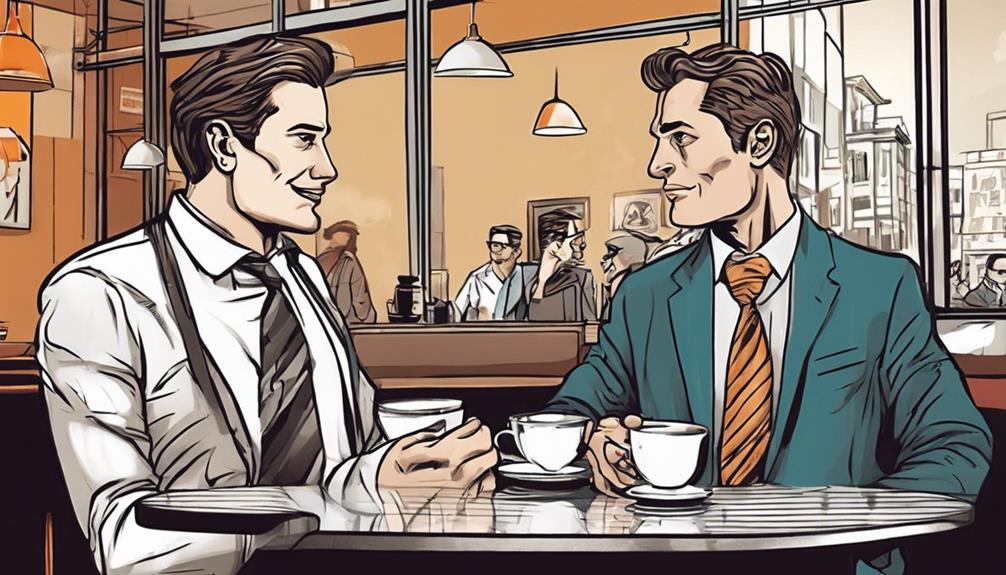
Dress professionally in formal attire to convey respect and dedication during coffee conversations. Make sure your clothing is neat, unwrinkled, and suitable for the occasion. Your attire speaks volumes about your professionalism.
Moreover, maintain a respectful demeanor throughout the interaction. A polite and courteous attitude demonstrates your commitment to the conversation. In addition, wearing a watch not only adds a touch of elegance but also showcases your punctuality and respect for others' time. Being on time is a sign of professionalism and consideration.
Behave appropriately during the coffee meeting. Handle payment situations gracefully and be prepared for various scenarios that may arise. Your behavior should reflect your professionalism and readiness to engage in meaningful discussions.
Effective Communication Strategies
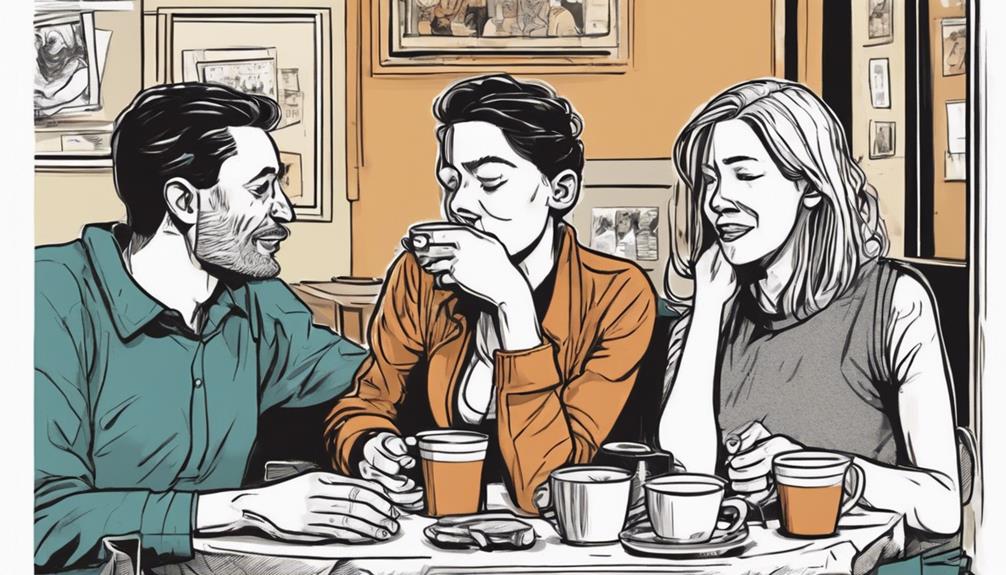
When responding to a coffee invitation, it's crucial to kick off your reply by introducing yourself clearly and expressing gratitude for the opportunity to engage in a meaningful conversation. This sets a positive tone for the upcoming meeting.
Following this, you should confirm your availability in the next message and suggest a few dates and times for the coffee chat. Offering flexibility in scheduling demonstrates your willingness to accommodate the other person's availability and makes it easier to find a suitable time to meet.
Expert Insights on Networking Importance

You know that networking is essential for your career growth. Understanding the impact of networking, building effective relationships, and implementing professional strategies can elevate your success.
Expert insights on networking importance can guide you to make the most out of your coffee meetings and connections.
Networking Impact Insights
Enhancing your networking skills is vital for maximizing career opportunities and professional growth. Networking can have a significant impact on your career trajectory, especially when it comes to virtual coffee chats.
Here are some insights on how networking can influence your professional life:
- Career Advancement: Networking allows you to connect with professionals in your industry, opening doors to new opportunities and potential career growth.
- Industry Insights: Through networking, you can gain valuable insights into your industry, staying informed about trends and developments that can benefit your career.
- Building Professional Relationships: Proper networking etiquette is pivotal for fostering strong professional relationships. Engaging in meaningful conversations during coffee chats can help you establish connections that may prove beneficial in the long run.
Effective Relationship Building
Networking effectively through coffee conversations can pave the way for valuable connections and opportunities in your professional journey. Building strong relationships through these interactions is key to enhancing your career growth and opening doors to mentorship. Understanding and practicing proper networking etiquette during coffee chats is crucial for successful relationship building. Experts emphasize the importance of networking for career advancement and gaining industry knowledge. By engaging in these conversations with style and professionalism, you can establish meaningful connections that can benefit your professional development in the long run.
| Networking Etiquette | Relationship Building | Career Growth |
|---|---|---|
| Actively listen | Show genuine interest | Seek new opportunities |
| Maintain eye contact | Express gratitude | Stay updated with industry trends |
| Follow up promptly | Offer support | Expand your network |
Professional Networking Strategies
Regularly attending networking events can greatly impact your professional growth and open doors to new opportunities in your career journey.
When it comes to professional networking strategies, remember that coffee meetings aren't just casual get-togethers; they're essential for building relationships, gaining insider insights, and receiving career guidance.
To make the most out of your networking experiences, it's essential to adhere to proper networking etiquette. Here are some key points to keep in mind:
- Research Meeting Partners: Before your coffee meeting, take the time to learn about the person you'll be meeting with. This shows genuine interest and helps steer the conversation in a meaningful direction.
- Dress Appropriately: Dressing professionally for a coffee meeting demonstrates respect for the occasion and your meeting partner.
- Maintain Professionalism: Always conduct yourself in a professional manner, even in a casual setting like a coffee meeting, as it can leave a lasting impression on others.
Tools for Networking and Maximizing Opportunities
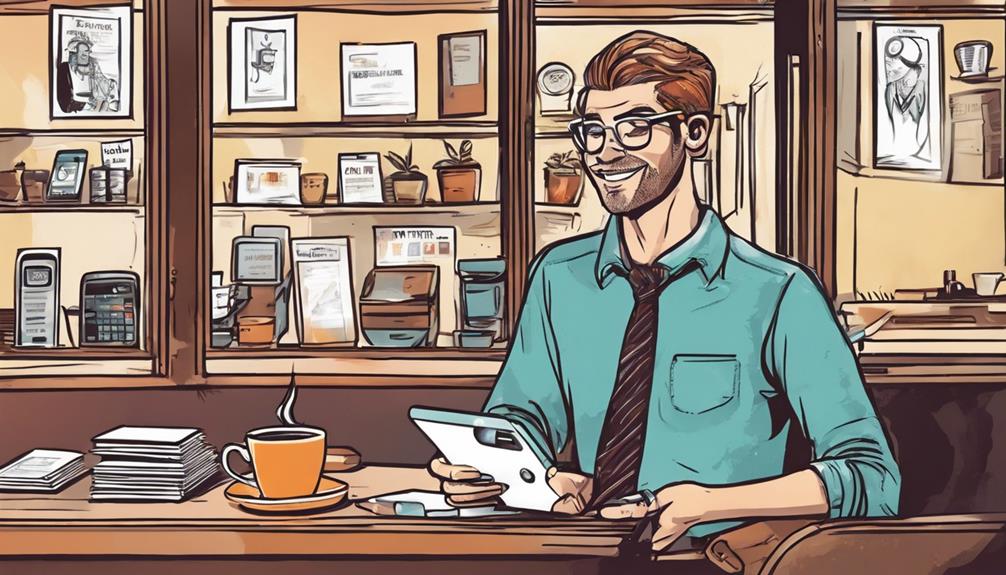
You can enhance your networking game by utilizing specialized tools like Zoom, Coffee Chat (App), and CoffeePals.
These platforms like Ten Thousand Coffees and Litespace Coffee Chat Tool offer features such as scheduling, virtual meeting spaces, and networking support to help you connect with professionals effectively.
Maximize your networking opportunities and build meaningful connections by leveraging these tools for networking with style.
Networking With Style
Utilize platforms like LinkedIn, Zoom, and CoffeePals to enhance your networking skills and maximize opportunities in a professional setting. Leveraging these tools can help you expand your professional network and foster meaningful connections.
To network with style, consider the following:
- Networking Etiquette: When engaging with professionals on platforms like LinkedIn or during virtual coffee chats on Zoom, remember to maintain a courteous and professional demeanor. Respect others' time and contributions, and always follow up promptly after networking interactions.
- Building Professional Relationships: Use platforms like Ten Thousand Coffees or Litespace Coffee Chat Tool to connect with industry peers and build lasting professional relationships. Engage in meaningful conversations, offer assistance, and seek opportunities for collaboration.
- Maximizing Networking Opportunities: Take advantage of hybrid work environments to meet new people and expand your network. Attend virtual networking events, participate in online industry forums, and explore employee-centric networking strategies to enhance your networking efforts and maximize opportunities for growth.
Maximizing Opportunities
Enhance your networking potential by leveraging innovative tools such as Zoom, Coffee Chat (App), and CoffeePals for impactful coffee chat interactions. These networking tools provide a platform to connect with professionals, share insights, and explore career opportunities, ultimately expanding your professional network and fostering meaningful connections. Additionally, platforms like Ten Thousand Coffees and Litespace Coffee Chat Tool offer unique features that can enhance your networking experiences and help you in your career growth journey.
Consider the table below for a quick comparison of these networking tools:
| Networking Tool | Key Features | Benefits |
|---|---|---|
| Zoom | Video conferencing, screen sharing | Connect with professionals remotely |
| Coffee Chat (App) | Instant messaging, group chats | Engage in group discussions |
| CoffeePals | Matching algorithm, virtual coffee meetings | Meet professionals with similar interests |
Frequently Asked Questions
How Do You Respond to a Coffee Invitation?
When you receive a coffee invitation, respond promptly with enthusiasm and suggest date and time options. Confirm the details in a friendly manner, expressing gratitude for the invite and excitement to connect over coffee.
How to Respond to a Request for Coffee Chat?
When responding to a request for a coffee chat, show enthusiasm and gratitude. Suggest dates, clarify objectives, and confirm logistics. Respect the requester's time and put your best foot forward for a successful meeting.
What Do You Say in a Coffee Chat Invitation?
When responding to a coffee chat invitation, express gratitude, confirm availability, share a brief intro, mention discussion interests, and end with enthusiasm to meet. Example: 'Thank you for the invite! I'm available then. Looking forward to chatting about our shared interests over coffee!'
How Do You Stand Out in a Coffee Chat?
To stand out in a coffee chat, engage genuinely by sharing your unique experiences and insights. Ask thoughtful questions. Show appreciation and follow up with a personalized thank-you email. Offer to reciprocate for a meaningful connection.
Conclusion
To wrap things up, remember to always dress to impress and confirm the location for your coffee conversation.
Make sure to plan your travel and expenses ahead of time, and always be mindful of your networking etiquette.
With effective communication and professionalism, you can maximize opportunities and leave a lasting impression.
So go ahead, seize the day and watch your career soar to new heights like a rocket launching into the stars!
Tips and Tricks
Vintage Vibes: How to Age Paper Coffee for a Retro Look!
Achieve a retro look by aging paper with coffee, adding a touch of vintage charm to your crafts.

Transform your paper with a vintage touch by aging it using coffee. Dilute instant coffee in hot water, apply and bake for a unique retro appearance. Experiment with different shades to add character. Be cautious of tea staining for archival concerns. Explore crafting origami, art journals, and home decor with aged paper. Enhance the effect by crumpling or burning the edges. For Halloween cards, use spooky stamps and ink for an ancient look. Remember to dry thoroughly for the best results. Curious to learn more techniques and tips for aging paper successfully?
Translate with U.S. English:
Transform your paper with a vintage touch by aging it using coffee. Dilute instant coffee in hot water, apply and bake for a unique retro appearance. Experiment with different shades to add character. Be cautious of tea staining for archival concerns. Explore crafting origami, art journals, and home decor with aged paper. Enhance the effect by crumpling or burning the edges. For Halloween cards, use spooky stamps and ink for an ancient look. Remember to dry thoroughly for the best results. Curious to learn more techniques and tips for aging paper successfully?
Key Takeaways
- Dilute instant coffee for a retro stain.
- Quick dry paper at 200 degrees for 2 mins.
- Experiment with coffee concentrations for varied shades.
- Crumple paper after staining for vintage effect.
- Incorporate tips for an authentic retro look.
Fast Coffee Staining Technique
To achieve a fast coffee staining technique for aging paper, start by diluting 2 tsp of instant coffee in 1/4 cup of hot water. This concentrated coffee solution will impart a rich, warm color to your paper, giving it that sought-after vintage appearance. Once you've prepared your coffee mixture, use a brush or sponge to apply it to the paper evenly.
Experiment with the concentration of the coffee mixture to achieve different shades of aging, allowing you to customize the look of your project.
After applying the coffee stain, you can speed up the drying process by baking the paper at 200 degrees for about 2 minutes. This quick technique not only helps in achieving a retro look but is also ideal for incorporating vintage vibes into various crafts and art projects.
Coffee staining provides an easy and effective way to add character and antiquity to your paper creations.
Archival Concerns With Tea Staining
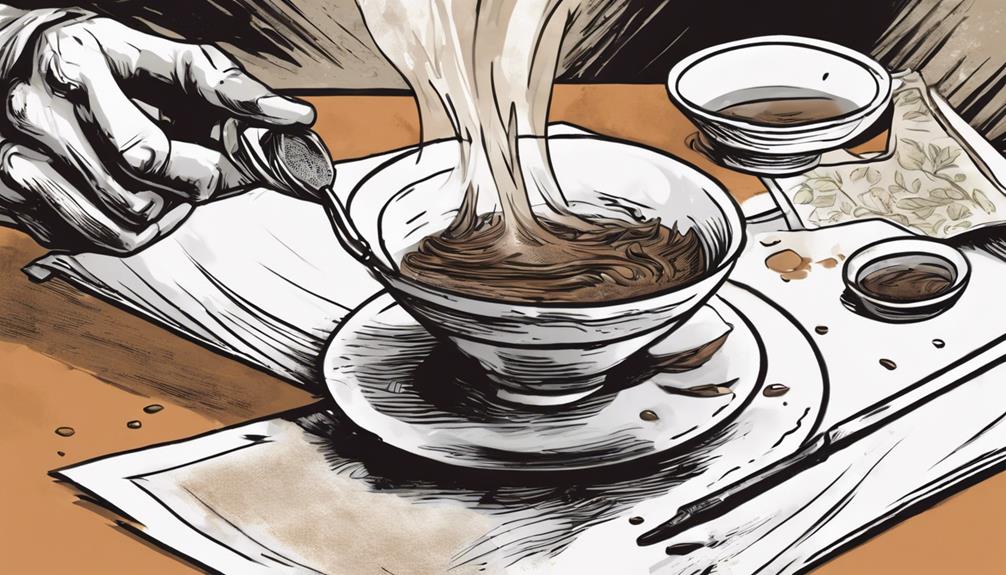
When tea staining paper for a vintage appearance, it's crucial to take into account the archival concerns associated with this method.
The tannic acid found in black tea can affect the longevity and quality of the paper, resulting in yellowing and fragility over time.
Conservationists recommend refraining from tea staining significant or fragile documents to guarantee their preservation.
Archival Implications of Tea Staining
Tea staining poses significant archival concerns due to the presence of tannic acid in black tea, which expedites the degradation of paper fibers over time.
When paper is stained with tea, the tannic acid interacts with the cellulose in the paper, leading to a breakdown of the fibers. This process can result in the paper losing its archival quality, making it susceptible to discoloration, brittleness, and potential damage.
The tannic acid's impact on paper fibers raises concerns about the long-term preservation of documents or artwork that have been tea-stained.
To maintain the archival integrity of your paper creations, it's advisable to explore alternative aging techniques that don't incorporate tannic acid. By being mindful of the materials and aging methods you use, you can guarantee that your vintage-inspired pieces stand the test of time without compromising their archival quality.
Preservation Concerns With Tea Aging
Consideration should be given to the preservation concerns associated with tea aging, particularly in relation to the archival implications of tannic acid's impact on paper fibers. When aging paper with tea, the presence of tannic acid can lead to a loss of archival quality as it degrades the paper fibers over time. The acidic nature of tannic acid poses a risk to the long-term preservation of aged paper, making it unsuitable for important documents or artwork that require archival standards. It is advisable to explore alternative aging methods that do not compromise the archival quality of the paper.
| Preservation Concerns With Tea Aging |
|---|
| Affects archival quality of aged paper |
| Tannic acid degrades paper fibers over time |
| Risk of deterioration due to tannic acid |
| Not suitable for preserving important documents |
| Consider alternative aging methods |
When considering aging paper for a retro look, it is essential to weigh the trade-off between aesthetic appeal and long-term preservation to maintain the integrity of the documents or artwork.
Tannic Acid Impact on Archival Quality
To preserve the archival quality of aged paper, it's vital to address the impact of tannic acid found in black tea staining. Tannic acid, present in black tea, can expedite the deterioration of paper by weakening its fibers over time.
The acidic nature of tannic acid contributes to the yellowing and brittleness of aged paper, raising archival concerns when using tea staining for important or long-term documents. The presence of tannic acid in tea can jeopardize the longevity and preservation of paper, making it less suitable for archival purposes.
It's advisable to explore alternative aging methods that don't involve tannic acid to guarantee the longevity and durability of important documents. By avoiding tannic acid in tea staining, you can mitigate the risks associated with decreased archival quality and safeguard your documents for future generations.
Versatile Aged Paper Projects
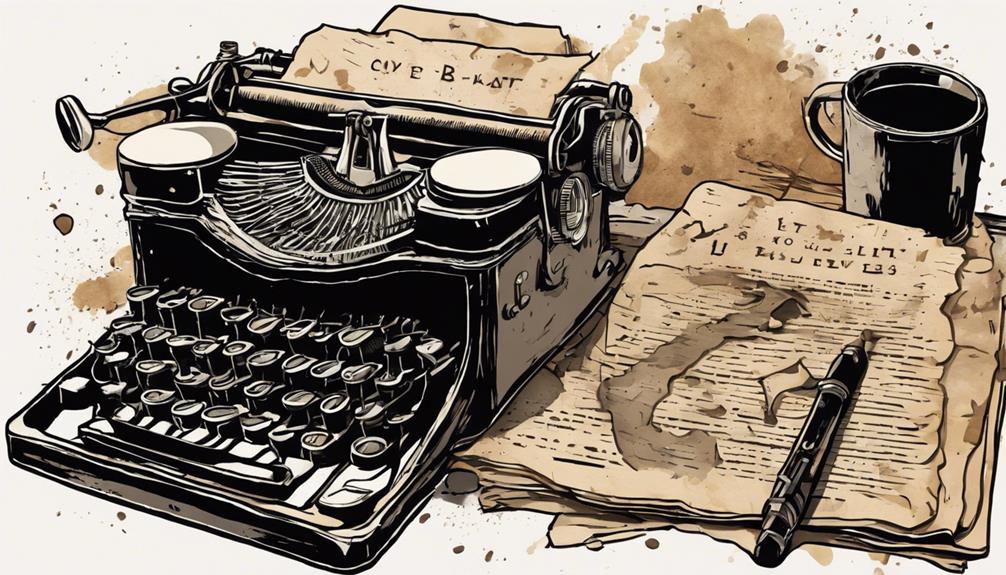
You can explore a multitude of project ideas with aged paper, ranging from scrapbooking to creating unique home decor pieces.
Experimenting with different decorative techniques like painting characters or scenes can elevate the vintage appeal of your crafts.
Let your creativity flow as you discover the endless possibilities that aged paper offers for your artistic endeavors.
Project Ideas
Exploring various ways to utilize aged paper in creative projects can lead to unique and visually appealing results. When it comes to incorporating aged paper into your crafts, the possibilities are endless. Here are some project ideas to get you started:
| Project Ideas | Description |
|---|---|
| Paper Crafts | Create intricate origami pieces or delicate paper flowers for a vintage feel. |
| Coffee or Tea Stained Art | Experiment with using different concentrations of coffee or tea to age paper for unique artwork. |
| Art Journals | Use aged paper as a base for your art journal pages, adding depth and character. |
| Home Decor | Incorporate aged paper into wall art, photo frames, or DIY vintage-inspired furniture. |
Whether you enjoy scrapbooking, card making, art journals, or simply want to add a retro touch to your home decor, aged paper can elevate your projects with a nostalgic charm. So grab your coffee or tea, start aging that paper, and let your creativity flow!
Decorative Techniques
Get ready to harness your creativity with versatile decorative techniques using aged paper for your projects. One popular method to make paper look old is by baking it in the oven on a cookie sheet. This technique not only adds an authentic antique look to your paper but also helps in achieving a vintage vibe for your crafts. By carefully monitoring the baking time and temperature, you can control the level of aging to match your desired aesthetic.
Aged paper is perfect for a wide range of projects, including scrapbooking, card making, art journals, and home decor. For example, creating vintage Christmas canvas art using aged paper can bring a festive touch to your holiday decorations. Additionally, aging book pages from your favorite novels can result in personalized and unique gifts that showcase your creativity.
Explore the possibilities of using aged paper as a canvas for painting characters or scenes. Experiment with different concentrations of coffee or tea to achieve varied results in aging paper, allowing you to customize your projects to suit your artistic vision.
Paper Aging Tutorial Steps
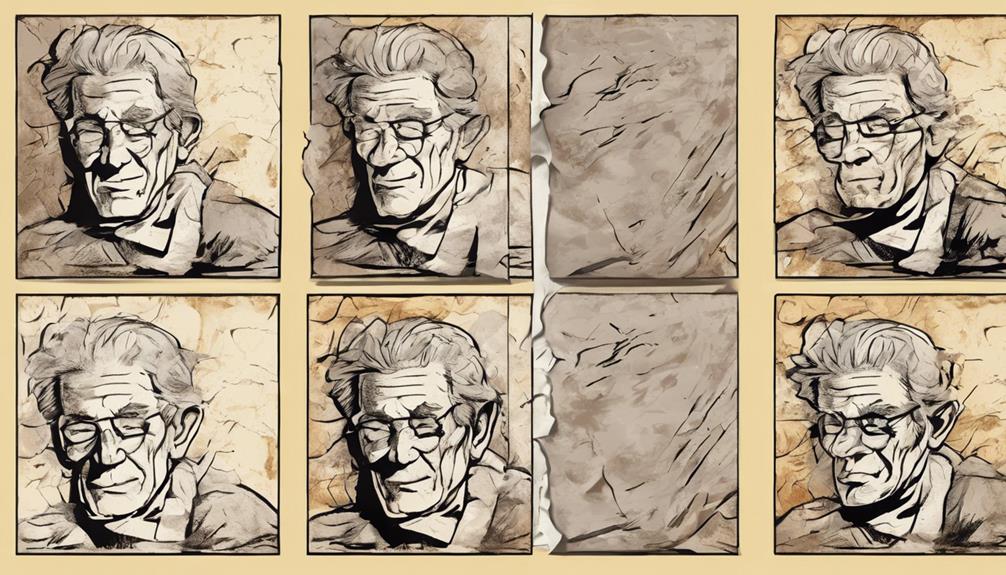
To begin the paper aging process, brew a strong batch of coffee to achieve the desired retro look on white paper. Using a brush, apply the coffee onto the piece of paper until you reach the shade of aging you prefer. Afterward, bake the paper at 200°F for 5-10 minutes to set the aging effect. For an extra vintage touch, stamp designs on the aged paper using brown pigment ink. Finally, trim the paper to your desired size and rub brown or black ink along the edges for a polished finish.
| Paper Aging Tutorial Steps |
|---|
| 1. Brew strong coffee |
| 2. Apply coffee to paper |
| 3. Bake at 200°F for 5-10 minutes |
| 4. Stamp designs using brown ink |
These steps will help you achieve that perfect retro look for your paper, adding a touch of nostalgia to your projects.
Necessary Materials and Preparation
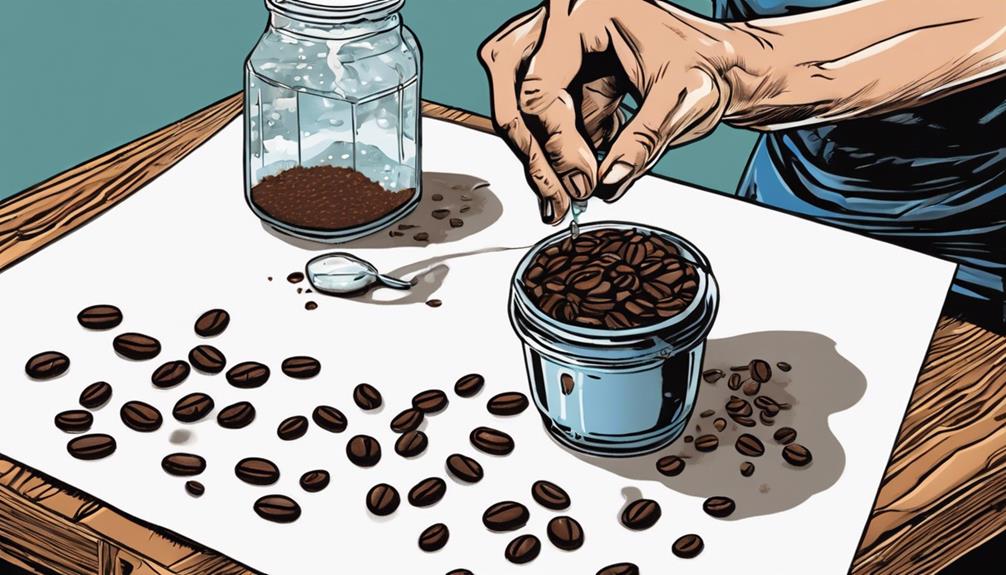
Consider using white paper or cardstock for aging with coffee to achieve the desired retro appearance. Start by brewing a strong cup of coffee and allowing it to cool. Place your piece of paper on a baking sheet to prevent any mess. Then, use a sponge or brush to evenly apply the coffee to the paper, making sure to cover the entire surface. You can also try dabbing the coffee on the paper with a paper towel for a more speckled effect. Let the paper dry completely before using it for any project. For an extra vintage touch, consider using this technique for creating recipe cards for your favorite Swedish coffee bread recipe.
Once your coffee is at room temperature, pour it into a shallow container. Dip a brush or sponge into the coffee and make sure the entire piece of paper is covered for an even effect. Experiment with different concentrations of coffee to achieve varying shades of aging.
If you want to add a fragrant touch to your aged paper, consider mixing in some cinnamon or vanilla extract with the coffee. Once you have achieved the desired appearance, allow the paper to dry completely before moving on to the next steps in the vintage paper aging process.
Enhancing the Vintage Paper Effect
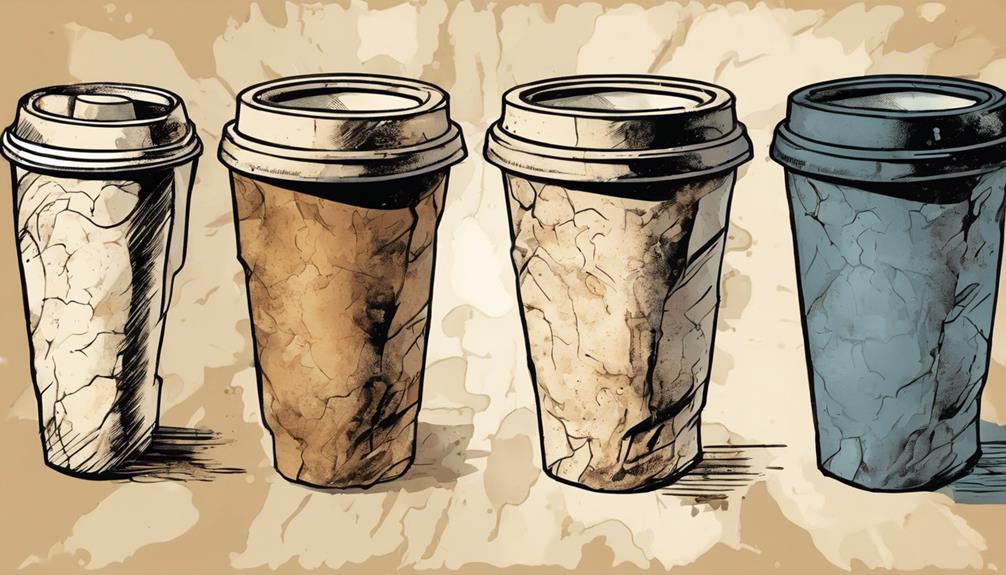
Enhance the vintage paper effect by incorporating various techniques to further age and distress the paper, elevating its retro aesthetic. Begin by crumpling the paper before staining it with coffee crystals to achieve a distressed and aged appearance.
Use a sponge brush to add a concentrated coffee or tea solution in specific areas for dark, aged spots on the paper. For an antique look, consider lightly burning the edges of the aged paper.
To create a sepia tone effect, apply a light coat of diluted coffee solution evenly across the paper. Once the paper has been aged to your liking, press it under heavy books to flatten and dry completely.
Spooky Halloween Card Making

For spooky Halloween card making, incorporate Halloween-themed rubber stamps and aged paper effects using coffee staining and baking techniques. To create eerie and unique cards, follow these steps:
- Choose Spooky Rubber Stamps: Opt for Halloween-themed rubber stamps like 'If Youve Got It, Haunt It' and 'Trick or Treat Yo Self' to add a touch of spookiness to your cards.
- Age Paper with Coffee Staining: Brush strongly brewed coffee onto white card stock paper to achieve an aged look reminiscent of ancient scrolls.
- Bake for Vintage Appeal: Bake the coffee-stained paper at 200°F for 5-10 minutes to enhance the vintage effect and make sure the ink sets properly.
- Add Authentic Touches: Trim the paper to size, then rub brown or black ink along the edges for an authentic, aged appearance that will make your Halloween cards stand out.
Experiment with different stamps and techniques to create personalized and spooky Halloween cards that will send chills down anyone's spine.
Tips for Aging Paper Successfully
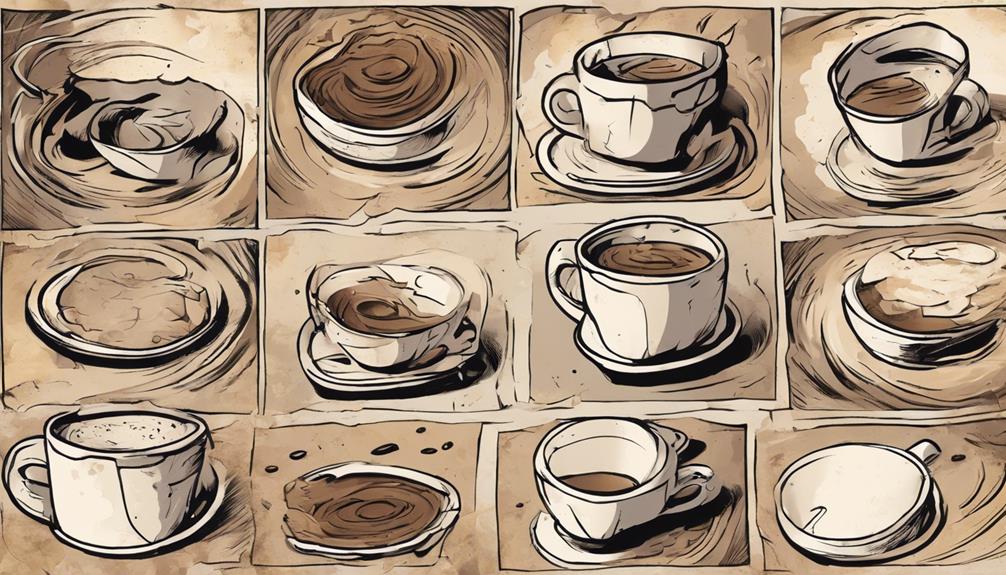
Wondering how to achieve the perfect aged look for your paper projects? Follow these tips for aging paper successfully. For a detailed guide to aging paper, consider the following techniques:
| Tip | Description |
|---|---|
| Dilute Instant Coffee | Mix 2 tsp of instant coffee in 1/4 cup hot water to create a coffee stain for an aged appearance. |
| Quick Drying with Heat | Bake stained paper at 200 degrees for 2 minutes to expedite the drying process. |
| Experiment with Tea Staining | Try different concentrations of tea for varied aging results, but be aware of potential quality loss. |
When aging paper, remember that crumpling the paper after staining can enhance its distressed and aged appearance. By incorporating these tips into your paper projects, you can achieve an authentic vintage look that will elevate your creations.
Frequently Asked Questions
How Do You Make Paper Look Vintage With Coffee?
To make paper look vintage with coffee, dilute 2 tsp of instant coffee in 1/4 cup hot water. Apply the solution with a brush or sponge, then bake at 200 degrees for 5-10 minutes. Experiment with concentrations for varying shades.
How to Make Printed Paper Look Old?
To make printed paper look old, layer ink prints like storytelling chapters. Blend distressed inks on diverse paper, creating a vintage masterpiece. Stamp textures, mix colors, and post-stamp for a retro feel. Turn ordinary prints into timeless treasures.
How to Tea Stain Paper to Look Old?
To tea stain paper to look old, steep a tea bag in hot water for 1 min. Apply the solution on white paper with a brush. Let it air dry for 2-3 hours or bake at 200 degrees for 2 min for a quicker result.
How Do You Age Shiny Paper?
To age shiny paper, crumple it for texture, sand lightly for a vintage look, apply diluted coffee or tea for stains, distress edges with a heat tool, and try techniques like ink distressing for a retro vibe.
Conclusion
Now that you've learned how to age paper for a retro look, the possibilities are endless! Just like a fine wine, paper only gets better with age.
So grab your supplies, get creative, and watch as your projects transform into timeless pieces with a vintage vibe.
Remember, aging paper is an art form that adds character and charm to any project, so don't be afraid to experiment and have fun with it!
-
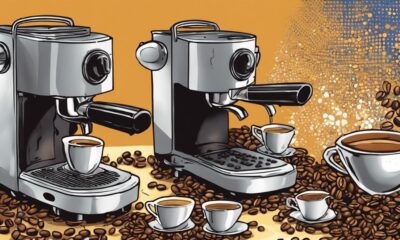
 Vetted4 days ago
Vetted4 days ago15 Best Lavazza for Espresso
-

 Industry News6 days ago
Industry News6 days agoDoes Jacobs Coffee Support Israel?
-

 Ryze Coffee14 hours ago
Ryze Coffee14 hours agoRyze Mushroom Coffee Vs Everyday Dose – Which Is Better for You?
-

 Vetted5 days ago
Vetted5 days ago15 Best Instant Espressos for Drinking Anytime, Anywhere – Taste Test Results & Reviews
-

 French Press7 days ago
French Press7 days agoUnderstanding How French Press Coffee Makers Work
-

 Industry News6 days ago
Industry News6 days agoDoes Coffee Bean Support Israel?
-

 Brewing Guides7 days ago
Brewing Guides7 days agoBrew Perfectly: How to Make Coffee with Coffee Maker
-

 Espresso10 hours ago
Espresso10 hours agoCaffeine in Espresso – How Much Do You Really Get?



























